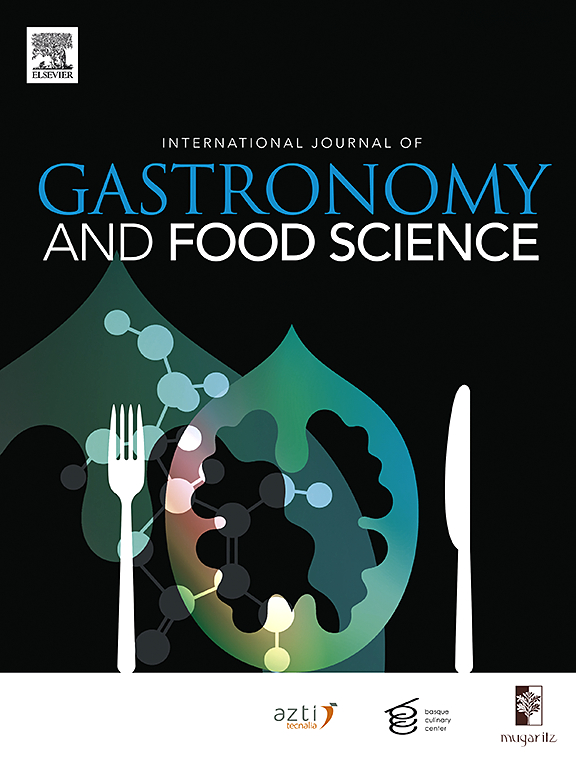Protein structural and textural characteristics of sous-vide cooked rainbow trout (Oncorhynchus mykiss) meat
IF 3.6
2区 农林科学
Q2 FOOD SCIENCE & TECHNOLOGY
International Journal of Gastronomy and Food Science
Pub Date : 2025-09-30
DOI:10.1016/j.ijgfs.2025.101313
引用次数: 0
Abstract
The global consumption of seafood is increasing, drawing attention to its high nutritional value. Sous-vide cooking minimizes nutrient loss and reduces heat-induced browning, making it a promising method for the future expansion of fish meat cooking. This study aimed to elucidate the details of temperature-dependent protein changes during sous-vide cooking of fish meat and to examine their relationship with texture. In our results, the hardness of rainbow trout meat decreased by heating, with the lowest hardness observed in meat cooked sous-vide at 50 °C. Biochemical analyses of proteins, including SDS-PAGE, immunoblotting, microscopic observation, and peptidomic analysis, revealed temperature-specific collagen denaturation, actin solubilization, sarcoplasmic protein aggregation, and myofibrillar protein degradation. Additionally, biophysical analyses using DSC and FTIR, confirmed thermal myosin denaturation above 40 °C and sarcoplasmic protein aggregation. Furthermore, a regression analysis of the hardness of rainbow trout meat as a function of sous-vide cooking temperature was conducted based on quantified protein changes. The regression model indicates that the progression of actin solubilization, collagen solubilization into cooking loss, collagen degradation, and myosin thermal denaturation contribute to softening of rainbow trout meat during sous-vide cooking. On the other hand, thermal aggregation of sarcoplasmic proteins, collagen thermal denaturation, and actin thermal denaturation may promote its hardening. These findings contribute to a more comprehensive understanding of the mechanism underlying textural changes of fish and meat depending on sous-vide cooking temperature.
真空烹调虹鳟鱼肉的蛋白质结构和质地特征
全球海产品的消费量正在增加,引起人们对其高营养价值的关注。真空烹调最大限度地减少了营养损失,减少了热致褐变,使其成为未来扩大鱼肉烹饪的一种有前途的方法。本研究旨在阐明低温烹饪鱼肉过程中蛋白质温度依赖性变化的细节,并研究其与质地的关系。在我们的研究结果中,虹鳟鱼肉的硬度随着加热而降低,在50°C的真空烹调条件下观察到的硬度最低。蛋白质的生化分析,包括SDS-PAGE、免疫印迹、显微镜观察和肽组学分析,揭示了温度特异性的胶原变性、肌动蛋白溶解、肌浆蛋白聚集和肌原纤维蛋白降解。此外,利用DSC和FTIR进行生物物理分析,证实了40°C以上的热肌球蛋白变性和肌浆蛋白聚集。此外,在定量蛋白质变化的基础上,对虹鳟鱼肉的硬度与真空烹调温度的关系进行了回归分析。回归模型表明,肌动蛋白增溶、胶原蛋白增溶为蒸煮损失、胶原蛋白降解和肌球蛋白热变性的过程是虹鳟肉在真空烹调过程中软化的主要原因。另一方面,肌浆蛋白的热聚集、胶原蛋白的热变性和肌动蛋白的热变性可能促进其硬化。这些发现有助于更全面地了解鱼和肉的质地变化的机制,这取决于真空烹调温度。
本文章由计算机程序翻译,如有差异,请以英文原文为准。
求助全文
约1分钟内获得全文
求助全文
来源期刊

International Journal of Gastronomy and Food Science
Social Sciences-Cultural Studies
CiteScore
5.30
自引率
10.50%
发文量
170
审稿时长
45 days
期刊介绍:
International Journal of Gastronomy and Food Science is a peer-reviewed journal that explicitly focuses on the interface of food science and gastronomy. Articles focusing only on food science will not be considered. This journal equally encourages both scientists and chefs to publish original scientific papers, review articles and original culinary works. We seek articles with clear evidence of this interaction. From a scientific perspective, this publication aims to become the home for research from the whole community of food science and gastronomy.
IJGFS explores all aspects related to the growing field of the interaction of gastronomy and food science, in areas such as food chemistry, food technology and culinary techniques, food microbiology, genetics, sensory science, neuroscience, psychology, culinary concepts, culinary trends, and gastronomic experience (all the elements that contribute to the appreciation and enjoyment of the meal. Also relevant is research on science-based educational programs in gastronomy, anthropology, gastronomic history and food sociology. All these areas of knowledge are crucial to gastronomy, as they contribute to a better understanding of this broad term and its practical implications for science and society.
 求助内容:
求助内容: 应助结果提醒方式:
应助结果提醒方式:


